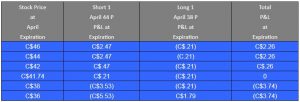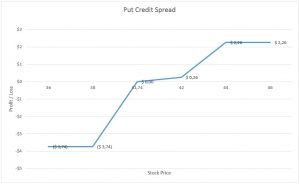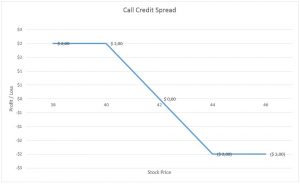Understanding Credit Spreads and How They Differ from Debit Spreads

In a previous posting, “Bull Call and Bear Put Spreads, Pairing Option Strategies with Forecasts” we learned how to implement a debit spread for both calls and puts. This week we will examine another form of vertical spreads: credit spreads and how they can be used.
Recall that debit spreads are a limited risk transaction, with the total risk being the amount paid for the spread and a known maximum potential profit. Credit spreads also have a known maximum potential profit, namely, the credit received from the sale of the spread. The maximum loss is the difference between the two strikes minus the credit received.
The bullish investor could initiate either a debit call spread or credit put spread. The credit put spread entails being short a higher strike put while simultaneously being long a lower strike put of the same underlying and expiration. A credit is generated as the higher strike put has a larger value than the purchase of the lower put. The credit put spread is also known as a Bull Put Spread, as it is a slightly neutral-to-bullish strategy and an alternative to selling a high-risk single put.
The bearish investor could choose to purchase a debit put spread or sell a credit call spread. The credit call spread is composed of shorting a near-the-money strike while simultaneously purchasing a higher strike call. The credit call spread is also known as a bear call spread and is appropriate for a neutral-to-slightly bearish forecast.
Just as we learned with debit spreads there are advantages and disadvantages with credit spreads. It is interesting to note that the P&L payoff profiles are identical once adjusted for the net cost to carry. The major differences are the cash flows in the investor’s trading account and the potential for early assignment associated with both the credit call and the credit put spreads.
Let’s examine the following Bull Put Credit Spread example:
Investor A believes that SU (Suncor Energy) currently trading at $C41.74 as of March 12, 2018 will remain in a narrow trading-range or move higher over the course of the next few months. The investor opts to sell a put credit spread. An April 20 expiry 44-strike put is sold at C$2.47 while simultaneously purchasing a 38-strike put at C$.21 cents for a net credit of C$2.26. Should SU rise or stay above the break-even point of C$41.74 (44 strike -2.26 =C$41.74) by expiration the investor will realize a profit. The credit spread has the advantage of time-decay over the debit spread; however, the credit spread has a risk of assignment on the short put. The investor’s forecast should be that of being ok with owning the shares below the 44 strike should assignment occur prior to or at expiration with the stock below 44. The long put protects the investor in case of early assignment (long 100 shares) by providing protection against a deeper price drop of the assigned underlying shares. The width in strike selection should be a function of your risk tolerance. A higher strike long put will reduce downside risk as well as potential profitability of the spread.
Short 1 SU April 20 expiry 44 put + Long 1 SU April 20 expiry 38 put

Stock Price at C$41.74 March 12, 2018
Note that C$41.74 is the break-even point for the Credit Put Spread. This is a bullish strategy with limited risk of $374 and limited potential reward of $226.
This strategy will profit if the stock closes above $41.74 by 04/20/2018.

Investor B has a different outlook and believes that SU currently trading at C$41.74 will either tread water or decline in price over the same period. Rather then purchasing a debit put spread, the investor sells an April 20 expiry 40 strike call at C$2.25 while simultaneously purchasing a 44 strike call for C$.25 or a combined C$2.00 credit.
Short 1 SU April expiry 40 call + Long 1 SU April expiry 44 call
This is a bearish strategy with limited risk of $200 and limited potential reward of $200.
This strategy will profit if the stock closes below C$42.00 by 04/20/2018.
The credit call spread has the advantage of time decay over the debit spread, however, the credit spread has risk of assignment on the short call. The investor should be ok with being short shares above the 40 strike should assignment occur before or at expiration with the stock above 40. The long 44 call protects the investor in case of assignment (short 100 shares) prior to expiration and a larger upward move of the underlying shares. Just like the put credit spread, strike selection should be based on the investors’ risk appetite. A lower strike long call will reduce upside risk while reducing potential profitability.


The question is often asked as to which is better the debit spread or the credit spread? As you might guess it depends on the investors’ comfort with being either long premium in the case of the debit spread or short premium in the case of the credit spread. Given that the investor is comfortable with understanding both the risks and rewards for each, implied volatility can then be the determinant for choosing a debit or credit spread. When implied volatility (IV) is low a debit spread will take advantage of any potential rise in volatility, and conversely, a credit spread will take advantage of any decrease from high-implied volatility.
Remember that the debit spread, has to fight time-decay and normally needs a directional move of the underlying in order to profit, but it does eliminate the assignment risk as the short option is covered by the long option. The credit spread has the risk of early assignment, but has the advantages of time decay and therefore can profit from the stock standing still as well as from the realized direction of the strategy.
As assignment can occur anytime prior to expiration on American Style options, it is important to have an exit plan if the investors intent is not to either be short or long shares. The most direct plan is to close the position to avoid assignment, or roll the strategy out in time to a later expiration.
It is essential to point out that this strategy needs to be actively Managed, so it is only suitable for investors with ample options trading experience.
CEO
Grigoletto Financial Consulting
Alan Grigoletto is CEO of Grigoletto Financial Consulting. He is a business development expert for elite individuals and financial groups. He has authored financial articles of interest for the Canadian exchanges, broker dealer and advisory communities as well as having written and published educational materials for audiences in U.S., Italy and Canada. In his prior role he served as Vice President of the Options Clearing Corporation and head of education for the Options Industry Council. Preceding OIC, Mr. Grigoletto served as the Senior Vice President of Business Development and Marketing for the Boston Options Exchange (BOX). Before his stint at BOX, Mr. Grigoletto was a founding partner at the investment advisory firm of Chicago Analytic Capital Management. He has more than 35 years of expertise in trading and investments as an options market maker, stock specialist, institutional trader, portfolio manager and educator. Mr. Grigoletto was formerly the portfolio manager for both the S&P 500 and MidCap 400 portfolios at Hull Transaction Services, a market-neutral arbitrage fund. He has considerable expertise in portfolio risk management as well as strong analytical skills in equity and equity-related (derivative) instruments. Mr. Grigoletto received his degree in Finance from the University of Miami and has served as Chairman of the STA Derivatives Committee. In addition, He is a steering committee member for the Futures Industry Association, a regular guest speaker at universities, the Securities Exchange Commission, CFTC, House Financial Services Committee and IRS.
The information provided on this website, including financial and economic data, quotes and any analysis or interpretation thereof, is provided solely for information purposes and shall not be construed in any jurisdiction as providing any advice or recommendation with respect to the purchase or sale of any derivative instrument, underlying security or any other financial instrument or as providing legal, accounting, tax, financial or investment advice. Bourse de Montréal Inc. recommends that you consult your own advisors in accordance with your needs before making decision to take into account your particular investment objectives, financial situation and individual needs.
All references on this website to specifications, rules and obligations concerning a product are subject to the rules, policies and procedures of Bourse de Montréal Inc. and its clearinghouse, the Canadian Derivatives Clearing Corporation, which prevail over the content of this website. Although care has been taken in the preparation of the documents published on this website, Bourse de Montréal Inc. and/or its affiliates do not guarantee the accuracy or completeness of the information published on this website and reserve the right to amend or review, at any time and without prior notice, the content of these documents. Neither Bourse de Montréal Inc. nor any of its affiliates, directors, officers, employees or agents shall be liable for any damages, losses or costs incurred as a result of any errors or omissions on this website or of the use of or reliance upon any information appearing on this website.
BAX®, CADC®, CGB®, CGF®, CGZ®, LGB®, MX®, OBX®, OGB®, OIS-MX®, ONX®, SCF®, SXA®, SXB®, SXF®, SXH®, SXM®, SXO®, SXY®, and USX® are registered trademarks of the Bourse. OBW™, OBY™, OBZ™, SXK™, SXJ™, SXU™, SXV™, Montréal Exchange and the Montréal Exchange logo are trademarks of the Bourse. All other trademarks used are the property of their respective owners.
© 2024 Bourse de Montréal Inc. All Rights Reserved.
